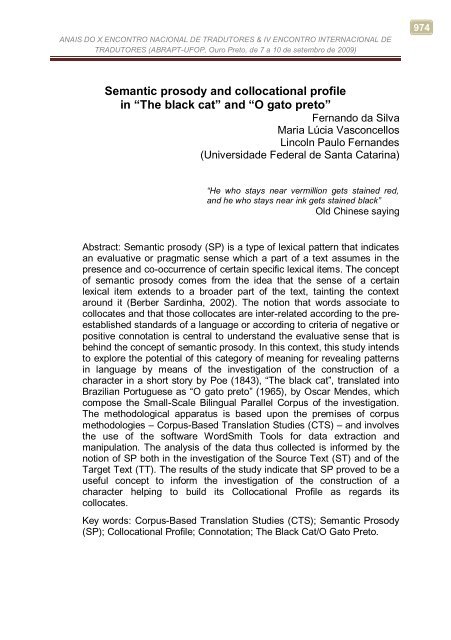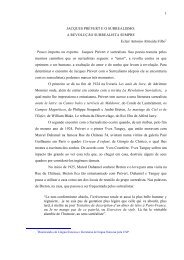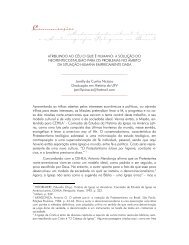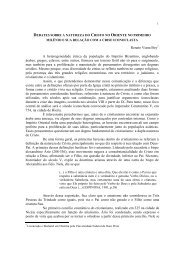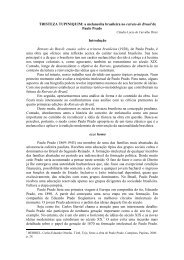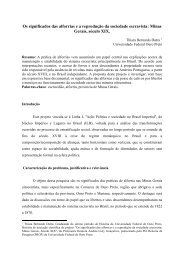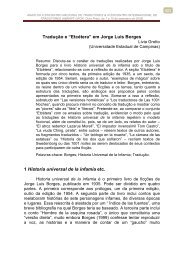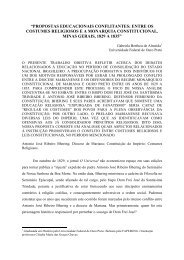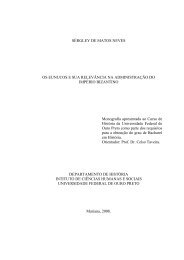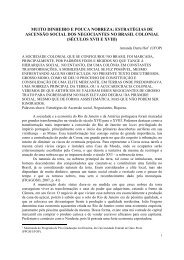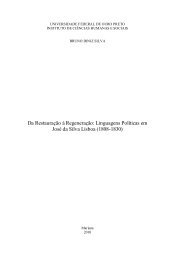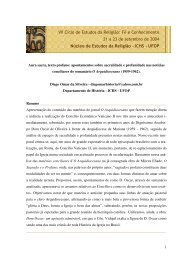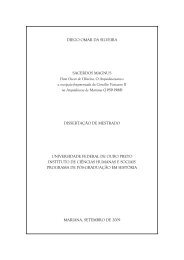semantic prosody and collocational profile in - ICHS/UFOP
semantic prosody and collocational profile in - ICHS/UFOP
semantic prosody and collocational profile in - ICHS/UFOP
Create successful ePaper yourself
Turn your PDF publications into a flip-book with our unique Google optimized e-Paper software.
ANAIS DO X ENCONTRO NACIONAL DE TRADUTORES & IV ENCONTRO INTERNACIONAL DE<br />
TRADUTORES (ABRAPT-<strong>UFOP</strong>, Ouro Preto, de 7 a 10 de setembro de 2009)<br />
Semantic <strong>prosody</strong> <strong>and</strong> <strong>collocational</strong> <strong>profile</strong><br />
<strong>in</strong> “The black cat” <strong>and</strong> “O gato preto”<br />
Fern<strong>and</strong>o da Silva<br />
Maria Lúcia Vasconcellos<br />
L<strong>in</strong>coln Paulo Fern<strong>and</strong>es<br />
(Universidade Federal de Santa Catar<strong>in</strong>a)<br />
“He who stays near vermillion gets sta<strong>in</strong>ed red,<br />
<strong>and</strong> he who stays near <strong>in</strong>k gets sta<strong>in</strong>ed black”<br />
Old Ch<strong>in</strong>ese say<strong>in</strong>g<br />
Abstract: Semantic <strong>prosody</strong> (SP) is a type of lexical pattern that <strong>in</strong>dicates<br />
an evaluative or pragmatic sense which a part of a text assumes <strong>in</strong> the<br />
presence <strong>and</strong> co-occurrence of certa<strong>in</strong> specific lexical items. The concept<br />
of <strong>semantic</strong> <strong>prosody</strong> comes from the idea that the sense of a certa<strong>in</strong><br />
lexical item extends to a broader part of the text, ta<strong>in</strong>t<strong>in</strong>g the context<br />
around it (Berber Sard<strong>in</strong>ha, 2002). The notion that words associate to<br />
collocates <strong>and</strong> that those collocates are <strong>in</strong>ter-related accord<strong>in</strong>g to the preestablished<br />
st<strong>and</strong>ards of a language or accord<strong>in</strong>g to criteria of negative or<br />
positive connotation is central to underst<strong>and</strong> the evaluative sense that is<br />
beh<strong>in</strong>d the concept of <strong>semantic</strong> <strong>prosody</strong>. In this context, this study <strong>in</strong>tends<br />
to explore the potential of this category of mean<strong>in</strong>g for reveal<strong>in</strong>g patterns<br />
<strong>in</strong> language by means of the <strong>in</strong>vestigation of the construction of a<br />
character <strong>in</strong> a short story by Poe (1843), “The black cat”, translated <strong>in</strong>to<br />
Brazilian Portuguese as “O gato preto” (1965), by Oscar Mendes, which<br />
compose the Small-Scale Bil<strong>in</strong>gual Parallel Corpus of the <strong>in</strong>vestigation.<br />
The methodological apparatus is based upon the premises of corpus<br />
methodologies – Corpus-Based Translation Studies (CTS) – <strong>and</strong> <strong>in</strong>volves<br />
the use of the software WordSmith Tools for data extraction <strong>and</strong><br />
manipulation. The analysis of the data thus collected is <strong>in</strong>formed by the<br />
notion of SP both <strong>in</strong> the <strong>in</strong>vestigation of the Source Text (ST) <strong>and</strong> of the<br />
Target Text (TT). The results of the study <strong>in</strong>dicate that SP proved to be a<br />
useful concept to <strong>in</strong>form the <strong>in</strong>vestigation of the construction of a<br />
character help<strong>in</strong>g to build its Collocational Profile as regards its<br />
collocates.<br />
Key words: Corpus-Based Translation Studies (CTS); Semantic Prosody<br />
(SP); Collocational Profile; Connotation; The Black Cat/O Gato Preto.<br />
974
ANAIS DO X ENCONTRO NACIONAL DE TRADUTORES & IV ENCONTRO INTERNACIONAL DE<br />
TRADUTORES (ABRAPT-<strong>UFOP</strong>, Ouro Preto, de 7 a 10 de setembro de 2009)<br />
1 Introduction<br />
1.1 Initial remarks<br />
This piece of research is carried out <strong>in</strong> the area of Translation<br />
Studies (TS) known as Corpus-based Translation Studies (CTS). With<strong>in</strong><br />
this framework, it draws specifically on the notion of <strong>semantic</strong> <strong>prosody</strong><br />
(SP), to describe the construction of a character <strong>in</strong> a short story by Poe<br />
(1843), “The black cat”, translated <strong>in</strong>to Brazilian Portuguese as “O gato<br />
preto” (1965), by Oscar Mendes, which compose the Small-Scale<br />
Bil<strong>in</strong>gual Parallel Corpus of the <strong>in</strong>vestigation. The study aims at<br />
describ<strong>in</strong>g “the consistent aura of mean<strong>in</strong>g with which a form is imbued<br />
by its collocates” (Louw, 1993, p. 157) that <strong>in</strong>dicates an evaluative or<br />
pragmatic sense that a lexical item assumes <strong>in</strong> consequence of the<br />
presence <strong>and</strong> co-occurrence of other lexical items. The selection of this<br />
specific notion is related to the fact that by means of the observation of<br />
<strong>semantic</strong> prosodic patterns <strong>and</strong> <strong>collocational</strong> <strong>profile</strong> it is possible to<br />
describe the construction of a character throughout a short story <strong>in</strong> terms<br />
of the evaluative representation as manifested <strong>in</strong> the narrative. In this<br />
specific case, the “character” whose construction is be<strong>in</strong>g observed <strong>and</strong><br />
described is the “cat” itself, here taken to be the protagonist of the short<br />
story. One of the ma<strong>in</strong> features of this character is the fact that its<br />
representation changes as the tale unfolds <strong>in</strong> consonance with changes<br />
occurr<strong>in</strong>g <strong>in</strong> its owner 1 . In this context, the hypothesis <strong>in</strong>form<strong>in</strong>g this<br />
research is that it is possible to trace the cat’s representation as the story<br />
unfolds by look<strong>in</strong>g at the <strong>semantic</strong> prosodies <strong>and</strong> <strong>collocational</strong> <strong>profile</strong><br />
related to this lexical item, here referred to as “node”, to use the term of<br />
corpus methodologies (Louw, 1993). From this <strong>in</strong>itial hypothesis, there<br />
emerge the follow<strong>in</strong>g Research Questions (RQs).<br />
(i) Is the SP <strong>in</strong> both texts an <strong>in</strong>dication of the way “the cat” is<br />
perceived <strong>and</strong> represented/constructed?<br />
(ii) What <strong>collocational</strong> <strong>profile</strong> emerges from the prosodic analysis<br />
of the node?<br />
(iii) Do the stylistic choices as manifested <strong>in</strong> the SP patterns <strong>in</strong><br />
the ST reflect the same <strong>semantic</strong> load <strong>in</strong> the story rendered <strong>in</strong><br />
the TT?<br />
1 Dávila-Montes. Available at: . Access on<br />
10 nov. 2011.<br />
975
ANAIS DO X ENCONTRO NACIONAL DE TRADUTORES & IV ENCONTRO INTERNACIONAL DE<br />
TRADUTORES (ABRAPT-<strong>UFOP</strong>, Ouro Preto, de 7 a 10 de setembro de 2009)<br />
1.2 Context of <strong>in</strong>vestigation<br />
This study is a replication of a previous study carried out <strong>in</strong><br />
Spanish by José Manuel Dávila-Montes, published <strong>in</strong> “Poe Translated by<br />
Cortázar” 2 , <strong>in</strong> which the author showed the evidence of the <strong>semantic</strong><br />
<strong>prosody</strong> <strong>in</strong> the word “cat/gato” <strong>and</strong> concepts referr<strong>in</strong>g to them, as well as<br />
the empirical evidence of “usefulness of corpora methodology applied<br />
with<strong>in</strong> language contrastive studies <strong>and</strong> translation” as he mentions <strong>in</strong><br />
his work. Dávila-Montes’s study differs from the present research,<br />
however, <strong>in</strong> that while the former <strong>in</strong>vestigates <strong>semantic</strong> <strong>prosody</strong> at work<br />
<strong>in</strong> the language pair English-Spanish, <strong>in</strong> the short story “The black cat”<br />
<strong>and</strong> its translation <strong>in</strong>to Spanish (1973), “El gato negro”, the present study<br />
explores the language pair English-Portuguese, <strong>in</strong> the translational<br />
relation between “The black cat” <strong>and</strong> “ O gato preto”. The relevance of<br />
the study can be claimed <strong>in</strong> terms of the application of the concept of<br />
<strong>semantic</strong> <strong>prosody</strong> to new data so as to confirm (or disconfirm) the validity<br />
of this framework to discursive translation studies.<br />
2 Review of literature<br />
The concept of SP is now presented with a view to characteriz<strong>in</strong>g<br />
its <strong>semantic</strong> nature when related to its collocates or certa<strong>in</strong> <strong>semantic</strong><br />
environments, trac<strong>in</strong>g the term<strong>in</strong>ology used to refer to this concept <strong>and</strong><br />
po<strong>in</strong>t<strong>in</strong>g out its contribution to TS. Also referred to as discourse <strong>prosody</strong>,<br />
SP relates to supra-segmental features of discourse, convey<strong>in</strong>g<br />
paral<strong>in</strong>guistic <strong>in</strong>formation such as irony, humor, sarcasm, ambiguity, etc.<br />
(Louw, 1993). Accord<strong>in</strong>g to Louw (1993), the scholar responsible for<br />
co<strong>in</strong><strong>in</strong>g this term, “the consistent aura of mean<strong>in</strong>g with which a form is<br />
imbued by its collocates is referred to as <strong>semantic</strong> <strong>prosody</strong>” (italics<br />
added). Louw (1993) attempts to explore the diagnostic capacity of<br />
<strong>semantic</strong> <strong>prosody</strong> <strong>and</strong> the role it plays <strong>in</strong> compos<strong>in</strong>g <strong>and</strong> grad<strong>in</strong>g<br />
persuasive language <strong>in</strong> adds, for example, as suggested <strong>in</strong> the same<br />
article. SP is a type of mean<strong>in</strong>g that <strong>in</strong>dicates an evaluative or pragmatic<br />
sense that a specific part of the text acquires <strong>in</strong> consequence of the<br />
presence <strong>and</strong> co-occurrence of certa<strong>in</strong> specific lexical items. The<br />
concept of <strong>semantic</strong> <strong>prosody</strong>, accord<strong>in</strong>g to Berber Sard<strong>in</strong>ha (2002),<br />
2 Available at: . Access on: 10 nov. 2011.<br />
976
ANAIS DO X ENCONTRO NACIONAL DE TRADUTORES & IV ENCONTRO INTERNACIONAL DE<br />
TRADUTORES (ABRAPT-<strong>UFOP</strong>, Ouro Preto, de 7 a 10 de setembro de 2009)<br />
comes from the idea that the sense of a certa<strong>in</strong> lexical item extends to a<br />
broader part of the text, ta<strong>in</strong>t<strong>in</strong>g the context around it. Part<strong>in</strong>gton (1998<br />
apud Berber Sard<strong>in</strong>ha, 2002) states that the sense of <strong>semantic</strong> choices<br />
depends on <strong>and</strong> reflects the various levels of the language. That is to<br />
say, the choices at word level depend on the choice of the context to<br />
which they are related. This context may comprehend patterns of cooccurrence,<br />
<strong>and</strong> these types of patterns can affect a larger stretch of the<br />
text, chang<strong>in</strong>g <strong>and</strong> modulat<strong>in</strong>g its sense. The study of SP is not restricted<br />
to the description of the word itself, but to the broader context that is part<br />
of it, to the choices that relate to a specific lexical item, <strong>and</strong> the various<br />
levels that compose a language system. In this sense, SP can be<br />
described as “a form of mean<strong>in</strong>g which is established through the<br />
proximity of a consistent series of collocates” (Louw, 2000 apud Xiao<br />
<strong>and</strong> McEnery, 2006). SP refers to the recurrent association between<br />
lexical items <strong>in</strong> a <strong>semantic</strong> field, <strong>in</strong>dicat<strong>in</strong>g a certa<strong>in</strong> connotation, positive,<br />
negative or neutral, or a certa<strong>in</strong> evaluative characteristic, says Berber<br />
Sard<strong>in</strong>ha (2002). Accord<strong>in</strong>g to the same author, the underst<strong>and</strong><strong>in</strong>g of the<br />
concept of <strong>semantic</strong> <strong>prosody</strong> is important for translation because it<br />
carries a mean<strong>in</strong>g that is not made explicit <strong>in</strong> dictionaries. The<br />
systematic analysis of translation through the concept of SP can shed<br />
light on questions related to adequacy <strong>and</strong> equivalence: although the<br />
study of SP is not predom<strong>in</strong>antly a contrastive or a translated-related<br />
type of study, the perception of this aspect of mean<strong>in</strong>g br<strong>in</strong>gs an<br />
important contribution to contrast<strong>in</strong>g different languages, especially when<br />
directly related to a specific language pair as is the purpose of this<br />
article.<br />
Accord<strong>in</strong>g to Louw (1993, p. 173), “<strong>semantic</strong> prosodies have <strong>in</strong><br />
large measure <strong>and</strong> for thous<strong>and</strong>s years rema<strong>in</strong>ed hidden from our<br />
perception <strong>and</strong> <strong>in</strong>accessible to our <strong>in</strong>tuition.” Thus to look at SP implies<br />
us<strong>in</strong>g corpus methodologies as this type of mean<strong>in</strong>g is “largely<br />
<strong>in</strong>accessible to human <strong>in</strong>tuition”, <strong>and</strong> which then requires the ref<strong>in</strong>ement<br />
of computer based methodologies (Louw, 1993, p. 157). It was only with<br />
the ref<strong>in</strong>ement of corpus methodologies <strong>and</strong> subsequently development<br />
of computer-based techniques that this phenomenon emerged as a<br />
fundamental segment of discourse.<br />
The notion of SP stems from a corpus-based approach with<strong>in</strong> an<br />
expressive <strong>and</strong> evaluative perspective on collocation, tak<strong>in</strong>g <strong>in</strong>to account<br />
the hypothesis that certa<strong>in</strong> lexical items tend to occur <strong>in</strong> the company of<br />
words or phrases which carry a predom<strong>in</strong>antly positive or negative sense<br />
977
ANAIS DO X ENCONTRO NACIONAL DE TRADUTORES & IV ENCONTRO INTERNACIONAL DE<br />
TRADUTORES (ABRAPT-<strong>UFOP</strong>, Ouro Preto, de 7 a 10 de setembro de 2009)<br />
<strong>in</strong> their orientation (Hampe, 2005). Such characteristic makes of<br />
<strong>semantic</strong> <strong>prosody</strong> <strong>and</strong> <strong>prosody</strong> highly contextual entities of mean<strong>in</strong>g.<br />
SP is closely related to the notion of collocation, systematized by<br />
S<strong>in</strong>clair <strong>in</strong> 1991 to refer to the tendency of certa<strong>in</strong> words to occur with<br />
certa<strong>in</strong> grammatical choices or certa<strong>in</strong> <strong>semantic</strong> environments. In this<br />
sense, it is possible to say that he gets close to explicitat<strong>in</strong>g the<br />
phenomenon of <strong>semantic</strong> <strong>prosody</strong> when, for example, the fact that<br />
certa<strong>in</strong> words show the tendency to occur <strong>in</strong> a certa<strong>in</strong> <strong>semantic</strong><br />
environment, for <strong>in</strong>stance, the verb “to happen” which he describes as<br />
be<strong>in</strong>g predom<strong>in</strong>antly associated to unpleasant events. Another famous<br />
example – later on replicated <strong>in</strong> the study of Berber Sard<strong>in</strong>ha (2002) <strong>in</strong><br />
Portuguese – is the phrasal verb “to set <strong>in</strong>”, which by means of a corpus<br />
approach was seen to possess an equally predom<strong>in</strong>ant ability to occur<br />
with words related to unpleasant events.<br />
Another characteristic of the SP of a certa<strong>in</strong> node is its capability<br />
of chang<strong>in</strong>g its polarity accord<strong>in</strong>g to transitivity. For <strong>in</strong>stance, the verb to<br />
build up when used transitively, as <strong>in</strong> build up organizations, better<br />
underst<strong>and</strong><strong>in</strong>g, etc, acquires a uniformly good <strong>prosody</strong>. When collocated<br />
with forces or th<strong>in</strong>gs, such as cholesterol, tox<strong>in</strong>s, armaments as <strong>in</strong> an<br />
<strong>in</strong>transitive form, as <strong>in</strong> to tox<strong>in</strong>s build up, it acquires an uniformly bad<br />
<strong>prosody</strong> (Louw, 1993, p. 171).<br />
The importance of contrast<strong>in</strong>g <strong>collocational</strong> behavior <strong>and</strong> SP<br />
becomes evident when deal<strong>in</strong>g with language pairs – which is the case<br />
<strong>in</strong> TS. The ma<strong>in</strong> question that arises from this is the extent to which the<br />
evidence of SP <strong>and</strong> prosodic features help word recognition <strong>in</strong><br />
translation. Accord<strong>in</strong>g to Berber Sard<strong>in</strong>ha (2002), SP is important for the<br />
underst<strong>and</strong><strong>in</strong>g of translation because although the isolated word carries<br />
an important mean<strong>in</strong>g, this mean<strong>in</strong>g is changed when seen <strong>in</strong> company<br />
of equivalent collocations for that specific word <strong>in</strong> the target language. In<br />
this sense, a translator may produce an <strong>in</strong>appropriate SP without be<strong>in</strong>g<br />
aware of it. In this sense, if the translator is not familiar with the concept<br />
of <strong>semantic</strong> <strong>prosody</strong> <strong>and</strong> its overall effect on translation, s/he may<br />
produce oddities <strong>in</strong> the translated text. In this sense, says Berber<br />
Sard<strong>in</strong>ha (2002), the study of collocates <strong>and</strong> SP, especially regard<strong>in</strong>g<br />
two languages, may throw light on questions of adequacy of equivalent<br />
lexical items.<br />
978
ANAIS DO X ENCONTRO NACIONAL DE TRADUTORES & IV ENCONTRO INTERNACIONAL DE<br />
TRADUTORES (ABRAPT-<strong>UFOP</strong>, Ouro Preto, de 7 a 10 de setembro de 2009)<br />
3 Method: corpus <strong>and</strong> analytical procedures<br />
This subsection is briefly discusses the contribution of corpusbased<br />
methodologies; presents the purpose of the corpus creation; the<br />
type of corpus under study; the process of corpus build<strong>in</strong>g <strong>and</strong> of corpus<br />
process<strong>in</strong>g; the delimitation of the object of analysis/node as well as the<br />
analytical procedures guid<strong>in</strong>g the study.<br />
The reflections made by Olohan (2004) <strong>and</strong> the methodological<br />
apparatus proposed by Fern<strong>and</strong>es (2004), <strong>in</strong> his unpublished PhD work<br />
(PGI – UFSC), <strong>in</strong>form the corpus methodology of this study, which is<br />
subdivided <strong>in</strong>to: (i) purpose of corpus creation; (ii) type of corpus; (iii)<br />
corpus build<strong>in</strong>g; (iv) corpus process<strong>in</strong>g; (iv) delimitation of the object of<br />
analysis; (v) delimitation of the node of analysis.<br />
The purpose of creat<strong>in</strong>g the present corpus was to <strong>in</strong>vestigate<br />
whether or not the SP <strong>and</strong> <strong>collocational</strong> patterns observed <strong>in</strong> a short<br />
story orig<strong>in</strong>ally written <strong>in</strong> English is present <strong>in</strong> the Brazilian Portuguese<br />
render<strong>in</strong>g of the same tale. More specifically, it is hypothesized that as<br />
“the word choice parallels very accurately the process of demonization of<br />
the cat by the storyteller” 3 the same parallelism occurs <strong>in</strong> the TT: based<br />
on a <strong>collocational</strong> perspective, the process of demonization of the<br />
protagonist of the short story is reflected <strong>in</strong> the <strong>semantic</strong> <strong>prosody</strong> of the<br />
lexical items referr<strong>in</strong>g to “the cat” (“cat”, “beast”, “animal”, “Pluto”,<br />
“creature”, “monster”, “pet”, “playmate”, “it”) <strong>and</strong> “o gato” (“gato”, “besta”,<br />
“animal”, “Plutão”, “criatura”, “monstro”, “animal de estimação”,<br />
“companheiro”, “ele”).<br />
As for the type of corpus <strong>in</strong> this study, its def<strong>in</strong>ition is based on<br />
criteria suggested by Fern<strong>and</strong>es (2204), accord<strong>in</strong>g to which a parallel<br />
corpus is usually classified accord<strong>in</strong>g to four parameters:<br />
(i) Number of languages: bil<strong>in</strong>gual, tril<strong>in</strong>gual or multil<strong>in</strong>gual if<br />
more than three languages represented;<br />
(ii) Temporal restriction: synchronic – when the object of study<br />
focuses a specific period of time, or diachronic – when the<br />
object of study is concerned with the historical development<br />
of the object of study throughout a period of time;<br />
(iii) Directionality: unidirectional, when it focuses on just one<br />
direction of translation (English rendered <strong>in</strong>to Brazilian<br />
Portuguese); bidirectional, when composed by L1 texts <strong>and</strong><br />
3 Available at: . Access on: 10 nov. 2011.<br />
979
ANAIS DO X ENCONTRO NACIONAL DE TRADUTORES & IV ENCONTRO INTERNACIONAL DE<br />
TRADUTORES (ABRAPT-<strong>UFOP</strong>, Ouro Preto, de 7 a 10 de setembro de 2009)<br />
its translation <strong>in</strong>to L2 plus the orig<strong>in</strong>al text <strong>in</strong> L2 <strong>and</strong> its<br />
translation <strong>in</strong>to L1; <strong>and</strong> multidirectional, when more than two<br />
languages are <strong>in</strong>volved <strong>and</strong> the translation analysis does not<br />
revolve around L1, but around the <strong>in</strong>teraction of the<br />
languages that make up the corpus.<br />
The type of corpus on which this study is based can be classified<br />
as a bil<strong>in</strong>gual, synchronic, specialized, <strong>and</strong> unidirectional parallel corpus.<br />
In addition, it is a small-scale corpus, <strong>in</strong> contrast with large scale<br />
corpora, both <strong>in</strong> terms of size <strong>and</strong> methodological terms. Corpus build<strong>in</strong>g<br />
<strong>in</strong> the present research is divided <strong>in</strong>to three stages: download<strong>in</strong>g <strong>and</strong><br />
proof read<strong>in</strong>g of ST <strong>and</strong> TT; edit<strong>in</strong>g <strong>and</strong> formatt<strong>in</strong>g; annotat<strong>in</strong>g. The first<br />
stage consisted <strong>in</strong> download<strong>in</strong>g the texts through the Internet, s<strong>in</strong>ce the<br />
short stories to be analyzed were already part of public record. The texts<br />
were edited <strong>and</strong> converted to .txt format <strong>and</strong> encoded accord<strong>in</strong>g to the<br />
norms required by the software Wordsmith Tools. The next step was to<br />
run the texts through a concordance program, which generated the lists<br />
of occurrences of the nodes to be analyzed.<br />
As regards the delimitation of the object of analysis, <strong>in</strong> a first<br />
moment only the lexical items “cat” <strong>and</strong> “gato” were looked at as they<br />
were expected to provide a clear description on how <strong>semantic</strong> <strong>prosody</strong><br />
operates with<strong>in</strong> the construction of the character. As that proved<br />
<strong>in</strong>sufficient, the procedure proposed by Dávila-Montes 4 was followed,<br />
which meant <strong>in</strong>clud<strong>in</strong>g the lexical items “cat”/“gato”, “beast”/“besta”,<br />
“animal”/”animal”, “Pluto”/“Plutão”, “creature/criatura”, monster”/“monstro,<br />
“pet”/“animal de estimação”, “playmate”/”companheiro” <strong>and</strong> “it”/“ele”, so<br />
as to trace evidences of the process of demonization <strong>in</strong> the figure of the<br />
“cat” <strong>in</strong> the short stories. Such lexical items were analyzed for<br />
<strong>collocational</strong> profil<strong>in</strong>g <strong>and</strong> SP description.<br />
4 Description <strong>and</strong> analysis<br />
4.1 Global statistics: general <strong>in</strong>formation on data<br />
The comparative <strong>and</strong> analytical <strong>in</strong>vestigation of both texts result<strong>in</strong>g<br />
from the observation of the statistics of their wordlists shows a relative<br />
difference <strong>in</strong> what concerns the analysis of the products provided by the<br />
4 Available at: . Access on: 10 nov. 2011.<br />
980
ANAIS DO X ENCONTRO NACIONAL DE TRADUTORES & IV ENCONTRO INTERNACIONAL DE<br />
TRADUTORES (ABRAPT-<strong>UFOP</strong>, Ouro Preto, de 7 a 10 de setembro de 2009)<br />
observation of the collocates <strong>and</strong> their respective word choices.<br />
Regard<strong>in</strong>g this specific aspect of both texts, the simple comparison of<br />
statistical results from both texts’ wordlists <strong>in</strong>dicates small differences<br />
regard<strong>in</strong>g the number of tokens <strong>and</strong> types 1, type/token ratio2,<br />
sentences, sentence length, st<strong>and</strong>ardized type/token ratio3 <strong>and</strong><br />
paragraph length. Figure 1 illustrates the comparison of the data<br />
obta<strong>in</strong>ed between the ST <strong>and</strong> its translated version. Column 1 refers to<br />
the overall data of both texts, be<strong>in</strong>g column 2, (THEBLA~1.TXT) referred<br />
to the source text, <strong>and</strong> column 2 (OGATOP~2.TXT) referred to the target<br />
text.<br />
Figure 1: Global statistics generated<br />
For purposes of correct alignment, the number of paragraphs <strong>in</strong><br />
the TT was modified <strong>in</strong> order to match the number of paragraphs <strong>in</strong> the<br />
ST. In the overall, the average paragraph length was similar <strong>in</strong> both<br />
texts. From a general overview of the analysis of both texts, the data<br />
generated display a certa<strong>in</strong> redistribution of concepts throughout the text,<br />
that is to say, as the tales unfold, the terms “cat”/“gato” are replaced with<br />
new representations <strong>in</strong> order to convey the way the cat is portrayed <strong>in</strong><br />
the story. This evidence is clearly shown by means of the data collected<br />
through Wordsmith Tools, consider<strong>in</strong>g the redistribution of concepts<br />
with<strong>in</strong> the texts, <strong>and</strong> by means of the comparative analysis of their word<br />
981
ANAIS DO X ENCONTRO NACIONAL DE TRADUTORES & IV ENCONTRO INTERNACIONAL DE<br />
TRADUTORES (ABRAPT-<strong>UFOP</strong>, Ouro Preto, de 7 a 10 de setembro de 2009)<br />
lists as follows <strong>in</strong> the next section. Still, by view<strong>in</strong>g the <strong>collocational</strong><br />
patterns related to the nodes of analysis, the overall tendency evidenced<br />
is the denom<strong>in</strong>ation of the “cat”/“gato” with concepts that reflect the<br />
stylistics of a horror story.<br />
4.2 Data generated by Wordsmith Tools<br />
From the <strong>in</strong>vestigation of the wordlists of both texts obta<strong>in</strong>ed it<br />
becomes evident that the TT differs form the ST <strong>in</strong> the aspects<br />
presented <strong>in</strong> Table 2. It is worth observ<strong>in</strong>g the redistribution of concepts<br />
throughout the texts.<br />
Table 2: Data Generated by Wordsmith Tools<br />
The text presents one occurrence of “pet” be<strong>in</strong>g translated as<br />
“bicho” three times, <strong>and</strong> once replac<strong>in</strong>g the concept “creature”. Also<br />
forty, out of the seventy occurrences of “it” with<strong>in</strong> the T, were directly<br />
referr<strong>in</strong>g to the figure of the “cat”, the rest referred either to other<br />
concepts such as the corpse of the wife, for example, or “it” was used<br />
due to the syntax of English that does not allow the use of a verb without<br />
an subject. The texts present a tendency towards redistribution of<br />
concepts. For example, as follows below, the extracts show an <strong>in</strong>stance<br />
of relocation of the concept be<strong>in</strong>g “pet” translated as “bicho”. This it<br />
treated <strong>in</strong> a generic way to refer to the cat, acquir<strong>in</strong>g a neutral prosodic<br />
load.<br />
Although I thus readily accounted to my<br />
reason, if not altogether to my conscience, for the startl<strong>in</strong>g<br />
982
ANAIS DO X ENCONTRO NACIONAL DE TRADUTORES & IV ENCONTRO INTERNACIONAL DE<br />
TRADUTORES (ABRAPT-<strong>UFOP</strong>, Ouro Preto, de 7 a 10 de setembro de 2009)<br />
fact just detailed, it did not the less fail to make a deep<br />
impression upon my fancy. For months I could not rid<br />
myself of the phantasm of the cat; <strong>and</strong>, dur<strong>in</strong>g this period,<br />
there came back <strong>in</strong>to my spirit a half-sentiment that<br />
seemed, but was not, remorse. I went so far as to regret<br />
the loss of the animal, <strong>and</strong> to look about me, among the vile<br />
haunts which I now habitually frequented, for another pet of<br />
the same species, <strong>and</strong> of somewhat similar appearance,<br />
with which to supply its place.<br />
Embora assim prontamente procurasse<br />
satisfazer a m<strong>in</strong>ha razão, senão de todo a m<strong>in</strong>ha<br />
consciência, a respeito do surpreendente fato que acabo<br />
de narrar, nem por isso deixou ele de causar profunda<br />
impressão na m<strong>in</strong>ha imag<strong>in</strong>ação. Durante meses, eu não<br />
me pude libertar do fantasma do gato e, nesse período,<br />
voltava-me ao espírito um vago sentimento que parecia<br />
remorso, mas não era. Cheguei a ponto de lamentar a<br />
perda do animal e de procurar, entre as tascas ord<strong>in</strong>árias<br />
que eu agora habitualmente freqüentava, outro bicho da<br />
mesma espécie e de aparência um tanto semelhante com<br />
que substituí-lo.<br />
Also, although unload the concept “animal” is viewed with a<br />
negative prosodic load, as is it visualized <strong>in</strong> Figures 1 <strong>and</strong> 2 ahead, the<br />
TT downloads the markedness of “beast” by translat<strong>in</strong>g it as “animal”<br />
which is not negatively connoted as “beast”.<br />
And now was I <strong>in</strong>deed wretched beyond<br />
the wretchedness of mere Humanity. And a brute beast -<br />
whose fellow I had contemptuously destroyed - a brute<br />
beast to work out for me - for me a man, fashioned <strong>in</strong> the<br />
image of the High God - so much of <strong>in</strong>sufferable wo! Alas!<br />
neither by day nor by night knew I the bless<strong>in</strong>g of Rest any<br />
more! Dur<strong>in</strong>g the former the creature left me no moment<br />
alone; <strong>and</strong>, <strong>in</strong> the latter, I started, hourly, from dreams of<br />
unutterable fear, to f<strong>in</strong>d the hot breath of the th<strong>in</strong>g upon my<br />
face, <strong>and</strong> its vast weight an <strong>in</strong>carnate Night-Mare that I had<br />
no power to shake off - <strong>in</strong>cumbent eternally upon my heart!<br />
E então eu era em verdade um desgraçado,<br />
mais desgraçado que a própria desgraça humana. E um<br />
bronco animal, cujo companheiro eu t<strong>in</strong>ha com desprezo<br />
destruído, um bronco animal preparava para mim - para<br />
mim, homem formado à imagem do Deus Altíssimo - tanta<br />
983
ANAIS DO X ENCONTRO NACIONAL DE TRADUTORES & IV ENCONTRO INTERNACIONAL DE<br />
TRADUTORES (ABRAPT-<strong>UFOP</strong>, Ouro Preto, de 7 a 10 de setembro de 2009)<br />
4.3 Discussion of the results<br />
angústia <strong>in</strong>tolerável! Ai de mim! Nem de dia nem de noite<br />
era-me dado mais gozar a bênção do repouso! Durante o<br />
dia, o bicho não me deixava um só momento e, de noite,<br />
eu despertava, a cada <strong>in</strong>stante, de sonhos de <strong>in</strong>dizível<br />
pavor, para sentir o quente hálito daquela coisa no meu<br />
rosto e o seu enorme peso, encarnação de pesadelo, que<br />
eu não t<strong>in</strong>ha forças para repelir, oprim<strong>in</strong>do eternamente o<br />
meu coração!<br />
This subsection explores the f<strong>in</strong>d<strong>in</strong>gs obta<strong>in</strong>ed from the wordlist.<br />
The comments are itemized for readability purposes.<br />
(i) The first aspect to st<strong>and</strong> out <strong>in</strong> Table 2 above is the fact that<br />
although fully representative of the occurrences related to<br />
this node, the list generated on the node “it” can lead to<br />
wrong assumptions on the analysis proposed. This figure<br />
alone does not tell much as “it” can be a pronoun referr<strong>in</strong>g<br />
to a number of elements <strong>in</strong> the short story, not only the<br />
“cat”. A qualitative analysis of this pronoun <strong>in</strong>dicates forty<br />
occurrences of it as referr<strong>in</strong>g to “the cat” <strong>in</strong> contrast to the<br />
Portuguese pronoun “ele”, <strong>in</strong> this specific conto, with 16<br />
(sixteen) occurrences referr<strong>in</strong>g to “o gato” specifically.<br />
(ii) A discrete <strong>in</strong>crease of the usage of “gato” (+1) as opposed<br />
to “cat”, <strong>and</strong> the omission of the word “besta” as opposed to<br />
eight occurrences of “beast” <strong>in</strong> the ST. In the TT all the<br />
<strong>in</strong>stances of “beast” were rendered <strong>in</strong>to Portuguese as<br />
“animal”. Even though the translator keeps the same<br />
negative load as <strong>in</strong> “beast”, which is itself “negatively<br />
connoted”, the <strong>semantic</strong> <strong>prosody</strong> of “animal” is also kept<br />
negative <strong>in</strong> TT by means of surround<strong>in</strong>g it by negative<br />
collocates <strong>in</strong> the parts that were <strong>and</strong> were not related to<br />
“beast”.<br />
One night, return<strong>in</strong>g home, much <strong>in</strong>toxicated,<br />
from one of my haunts about town, I fancied that the cat<br />
avoided my presence. I seized him; when, <strong>in</strong> his fright at<br />
my violence, he <strong>in</strong>flicted a slight wound upon my h<strong>and</strong> with<br />
984
ANAIS DO X ENCONTRO NACIONAL DE TRADUTORES & IV ENCONTRO INTERNACIONAL DE<br />
TRADUTORES (ABRAPT-<strong>UFOP</strong>, Ouro Preto, de 7 a 10 de setembro de 2009)<br />
his teeth. The fury of a demon <strong>in</strong>stantly possessed me. I<br />
knew myself no longer. My orig<strong>in</strong>al soul seemed, at once,<br />
to take its flight from my body <strong>and</strong> a more than fiendish<br />
malevolence, g<strong>in</strong>-nurtured, thrilled every fibre of my frame. I<br />
took from my waistcoat-pocket a pen-knife, opened it,<br />
grasped the poor beast by the throat, <strong>and</strong> deliberately cut<br />
one of its eyes from the socket! I blush, I burn, I shudder,<br />
while I pen the damnable atrocity.<br />
Certa noite, de volta a casa, bastante<br />
embriagado, de uma das tascas dos subúrbios, supus que<br />
o gato evitava m<strong>in</strong>ha presença. Agarrei-o, mas, nisto,<br />
amedrontado com a m<strong>in</strong>ha violência ele me deu uma leve<br />
dentada na mão. Uma fúria diabólica apossou-se<br />
<strong>in</strong>stantaneamente de mim. Cheguei a desconhecer-me.<br />
Parecia que alma orig<strong>in</strong>al me havia ab<strong>and</strong>onado de<br />
repente o corpo e uma maldade mais do que satânica,<br />
saturada de álcool, fazia vibrar todas as fibras de meu<br />
corpo. Tirei do bolso do colete um canivete, abri, agarrei o<br />
pobre animal pela garganta e, deliberadamente, arranqueilhe<br />
um dos olhos da órbita! Coro, abraso-me, estremeço ao<br />
narrar a condenável atrocidade.<br />
(iii) An overwhelm<strong>in</strong>g <strong>in</strong>crease of usage of the word “animal”<br />
(+12) as opposed to “animal” <strong>in</strong> the ST, also, “creature” with<br />
five occurrences, as opposed to three <strong>in</strong> the TT. The word<br />
“playmate”, translated as “companheiro” <strong>and</strong> as showed <strong>in</strong><br />
the alignment (Appendix 20), presents <strong>and</strong> <strong>in</strong>creases the<br />
usage <strong>in</strong> (+1) as opposed to “playmate” with one<br />
occurrence. The node “pet” as <strong>in</strong> “animal de estimação” or<br />
similar concepts is not presented <strong>in</strong> the TT, but <strong>in</strong> a two<br />
<strong>in</strong>stances it is presented as “bicho(s)”.<br />
Pluto - this was the cat's name - was my<br />
favorite pet <strong>and</strong> playmate. I alone fed him, <strong>and</strong> he attended<br />
me wherever I went about the house. It was even with<br />
difficulty that I could prevent him from follow<strong>in</strong>g me through<br />
the streets.<br />
Plutão - assim se chamava o gato - era o<br />
meu preferido e companheiro. Só eu lhe dava de comer e<br />
ele me acompanhava por toda a parte da casa, por onde<br />
eu <strong>and</strong>asse. Era mesmo com dificuldade que eu conseguia<br />
impedi-lo de acompanhar-me pelas ruas.<br />
985
ANAIS DO X ENCONTRO NACIONAL DE TRADUTORES & IV ENCONTRO INTERNACIONAL DE<br />
TRADUTORES (ABRAPT-<strong>UFOP</strong>, Ouro Preto, de 7 a 10 de setembro de 2009)<br />
(iv) As to “Pluto/Plutão” <strong>and</strong> “Monster/Monstro” the number of<br />
occurrences rema<strong>in</strong>s the same, translat<strong>in</strong>g them <strong>in</strong><br />
consonance with the same concepts <strong>in</strong> the source text.<br />
Of my own thoughts it is folly to speak.<br />
Swoon<strong>in</strong>g, I staggered to the opposite wall. For one <strong>in</strong>stant<br />
the party upon the stairs rema<strong>in</strong>ed motionless, through<br />
extremity of terror <strong>and</strong> of awe. In the next, a dozen stout<br />
arms were toil<strong>in</strong>g at the wall. It fell bodily. The corpse,<br />
already greatly decayed <strong>and</strong> clotted with gore, stood erect<br />
before the eyes of the spectators. Upon its head, with red<br />
extended mouth <strong>and</strong> solitary eye of fire, sat the hideous<br />
beast whose craft had seduced me <strong>in</strong>to murder, <strong>and</strong> whose<br />
<strong>in</strong>form<strong>in</strong>g voice had consigned me to the hangman. I had<br />
walled the monster up with<strong>in</strong> the tomb!<br />
Loucura seria falar de meus próprios<br />
pensamentos. Desfalecendo, recuei até a parede oposta.<br />
Durante um m<strong>in</strong>uto, o grupo que se achava na escada<br />
ficou imóvel, no paroxismo do medo e do pavor. Logo<br />
depois, uma dúzia de braços robustos se atarefava em<br />
desmantelar a parede. Ela caiu <strong>in</strong>teiriça. O cadáver, já<br />
gr<strong>and</strong>emente decomposto, e manchado de coágulos de<br />
sangue, erguia-se, ereto, aos olhos dos espectadores.<br />
Sobre sua cabeça, com a boca vermelha escancarada, o<br />
olho solitário chispante, estava assentado o horrendo<br />
animal cuja astúcia me <strong>in</strong>duzira ao crime e cuja voz<br />
delatora me havia apontado ao carrasco. Eu havia<br />
emparedado o monstro no túmulo!<br />
From these observations it is possible to say that the TT<br />
downloads the markedness of the ST as regards the construction of the<br />
character “the cat”. In fact, it neutralizes the connotations pervad<strong>in</strong>g the<br />
concept “cat”, which is translated as “gato”, “animal”, <strong>and</strong> not as marked<br />
forms as happens <strong>in</strong> the ST, with expressions such as <strong>in</strong> “creature”,<br />
“beast”,“Pluto” <strong>and</strong> “playmate”. However, these latter <strong>in</strong>stances are<br />
predom<strong>in</strong>antly related to a <strong>semantic</strong> prosodic load, that is to say, when<br />
the character is explicitly <strong>in</strong>tended to be displayed <strong>in</strong> a good or bad way.<br />
As <strong>in</strong> the beg<strong>in</strong>n<strong>in</strong>g when it is addressed by its name “Pluto/Plutão” or<br />
“playmate/companheiro”, <strong>and</strong> <strong>in</strong> the end when it is no longer viewed as<br />
the same lovely animal it was viewed <strong>in</strong> the beg<strong>in</strong>n<strong>in</strong>g. From an<br />
observation of the plot analysis referr<strong>in</strong>g to the ma<strong>in</strong> nodes, it becomes<br />
evident that the words “cat” <strong>and</strong> “Pluto” <strong>in</strong> the ST tend to concentrate at<br />
986
ANAIS DO X ENCONTRO NACIONAL DE TRADUTORES & IV ENCONTRO INTERNACIONAL DE<br />
TRADUTORES (ABRAPT-<strong>UFOP</strong>, Ouro Preto, de 7 a 10 de setembro de 2009)<br />
the beg<strong>in</strong>n<strong>in</strong>g of the story. Be<strong>in</strong>g the “cat” located between 0 <strong>and</strong> 70% of<br />
story but hav<strong>in</strong>g its maximum concentration <strong>in</strong> the stretch of 35 to 55% of<br />
the story length, <strong>and</strong> the node “Pluto”, from the 12 to 54% of the story<br />
length .<br />
Figure 2: Node “Pluto”<br />
Figure 3: Node “Cat”<br />
987
ANAIS DO X ENCONTRO NACIONAL DE TRADUTORES & IV ENCONTRO INTERNACIONAL DE<br />
TRADUTORES (ABRAPT-<strong>UFOP</strong>, Ouro Preto, de 7 a 10 de setembro de 2009)<br />
On the other h<strong>and</strong>, from an observation of the plot analysis<br />
referr<strong>in</strong>g to “cat”, “beast”, “creature” <strong>and</strong> “monster” <strong>in</strong> both languages, it<br />
becomes evident that the concepts “cat” <strong>and</strong> “gato” <strong>in</strong>terest<strong>in</strong>gly<br />
disappear around 70% of the text, be<strong>in</strong>g replaced by other substitutes<br />
such as “animal”, “beast”, “monster” <strong>and</strong> “it”, as the most common ones.<br />
On the whole, the 11 occurrences of concepts are located <strong>in</strong> the same<br />
length of both texts. This way, as the figure of the “cat” starts to be<br />
demonized by its owner, at the same time, it starts be<strong>in</strong>g referred to by<br />
means of concepts loaded with a more negative or neutral <strong>semantic</strong><br />
<strong>prosody</strong>. Based on these comments the follow<strong>in</strong>g results <strong>and</strong><br />
conclusions can be drawn to illustrate this hypothesis as showed <strong>in</strong> the<br />
next paragraphs. Due to be<strong>in</strong>g treated as a generic concept represent<strong>in</strong>g<br />
a specific character, or as already mentioned common denom<strong>in</strong>ations of<br />
the concepts, the words “cat” <strong>and</strong> “gato” are present <strong>in</strong> most part of the<br />
story, show<strong>in</strong>g a neutral <strong>semantic</strong> <strong>prosody</strong>. As the story moves towards<br />
the end, “cat” <strong>and</strong> “gato” start be<strong>in</strong>g conveyed by “animal”, “beast”,<br />
“monster”, “creature” <strong>and</strong> “it” <strong>in</strong> the ST, “animal”, “monstro” <strong>and</strong> “criatura”<br />
<strong>in</strong> the TT. That is to say, concepts loaded with a negative <strong>semantic</strong><br />
<strong>prosody</strong>. More affectionate forms such as “playmate/companheiro” or the<br />
simple address by its name as it is <strong>in</strong> “Pluto/Plutão” disappear <strong>in</strong> the<br />
beg<strong>in</strong>n<strong>in</strong>g of the story, more precisely. These characteristics if not<br />
determ<strong>in</strong>ant at least provide evidence for a tendency towards<br />
demoniz<strong>in</strong>g of the character the “cat/gato”, view<strong>in</strong>g it with a satanic<br />
image, <strong>and</strong> also for the process of degradation of its owner,<br />
dist<strong>in</strong>guish<strong>in</strong>g what it is a l<strong>in</strong>ear process based on lexical choices, that is<br />
to say, as the tales unfolds <strong>and</strong> the level affection on the cat grows<br />
dimmer, <strong>and</strong> the degradation of its owner becomes apparent, as a result<br />
of that, the lexical choices concern<strong>in</strong>g the ma<strong>in</strong> character are changed..<br />
Also, “animal/animal” is presented <strong>in</strong> both <strong>in</strong>stances as hav<strong>in</strong>g mostly a<br />
negative <strong>semantic</strong> <strong>prosody</strong>, that is to say, <strong>in</strong> moments were the cat’s<br />
owner associates his disgrace to the existence of the animal.<br />
Besides present<strong>in</strong>g more occurrences of the concept “animal” if<br />
compared to the ST, the concept “animal” <strong>in</strong> the TT also carries a<br />
negative <strong>semantic</strong> <strong>prosody</strong> load, be<strong>in</strong>g associated meanly to collocate<br />
such as “pavor”, “ódio”, “horror”, “pobre”, “horrendo, “bronco”, “matava”,<br />
“perda”, etc. Although <strong>in</strong> English a lower number of occurrences is made<br />
evident, the same concept , “animal”, is also associated, <strong>in</strong> most of the<br />
cases, to negatively loaded forms, for example, “blow at the animal”,<br />
“horror”, “crafty”, “loss of the animal”, “rope about the animal’s neck”, etc.<br />
988
ANAIS DO X ENCONTRO NACIONAL DE TRADUTORES & IV ENCONTRO INTERNACIONAL DE<br />
TRADUTORES (ABRAPT-<strong>UFOP</strong>, Ouro Preto, de 7 a 10 de setembro de 2009)<br />
Figure 4: Node “Animal” (TT)<br />
Even though the number of occurrences is <strong>in</strong>creased <strong>in</strong> the TT,<br />
the translation keeps the predom<strong>in</strong>ance of the same negative <strong>semantic</strong><br />
<strong>prosody</strong> for animal.<br />
Figure 5: Node “Animal” (ST)<br />
989
ANAIS DO X ENCONTRO NACIONAL DE TRADUTORES & IV ENCONTRO INTERNACIONAL DE<br />
TRADUTORES (ABRAPT-<strong>UFOP</strong>, Ouro Preto, de 7 a 10 de setembro de 2009)<br />
Although the concept animal is also referred to with a positive <strong>and</strong><br />
neutral prosodic load, yet it ma<strong>in</strong>ta<strong>in</strong>s a predom<strong>in</strong>ant negative <strong>prosody</strong> <strong>in</strong><br />
the TT. As mentioned <strong>in</strong> the <strong>in</strong>troduction, this article is <strong>in</strong>spired by<br />
previous work by José Manual Dávilla-Montes, <strong>in</strong> which he proposes to<br />
evidence “the empirical usefulness of corpora methodology applied<br />
with<strong>in</strong> contrastive studies <strong>and</strong> translation”, by means of view<strong>in</strong>g the<br />
<strong>collocational</strong> <strong>profile</strong> of the analyzed nodes <strong>and</strong> their <strong>semantic</strong> <strong>prosody</strong>.<br />
Just as with Dávilla-Montes’ work, it becomes clear that collocates<br />
behave as word-choice modulators for translators, <strong>and</strong> these word<br />
choices somehow parallel the <strong>semantic</strong> <strong>prosody</strong> of a node as the story<br />
comes to its end.<br />
5 Conclusion<br />
This piece of research was carried out <strong>in</strong> the area of Translation<br />
Studies (TS) known as Corpus-based Translation Studies (CTS). With<strong>in</strong><br />
this framework, it drew specifically on the notion of <strong>semantic</strong> <strong>prosody</strong>, to<br />
describe the construction of a character <strong>in</strong> a short story by Poe (1843),<br />
“The black cat”, translated <strong>in</strong>to Brazilian Portuguese as “O gato preto”<br />
(1965), by Oscar Mendes, which composed the Small-Scale Bil<strong>in</strong>gual<br />
Parallel Corpus of the <strong>in</strong>vestigation. The study aimed at describ<strong>in</strong>g “the<br />
consistent aura of mean<strong>in</strong>g with which a form is imbued by its collocates”<br />
(Louw, 1993, p. 157), that <strong>in</strong>dicates an evaluative or pragmatic sense<br />
that a lexical item assumes <strong>in</strong> consequence of the presence <strong>and</strong> cooccurrence<br />
of other lexical items. The selection of this specific notion<br />
was related to the fact that by means of the observation of prosodic <strong>and</strong><br />
<strong>collocational</strong> patterns it was possible to describe the construction of a<br />
character throughout a short story <strong>in</strong> terms of the evaluative<br />
representation as manifested <strong>in</strong> the narrative. In this specific case, the<br />
“character” whose construction was observed <strong>and</strong> described was the<br />
“cat/gato” itself, the protagonist of the short stories established <strong>in</strong> the<br />
analyses of the tales. One of the ma<strong>in</strong> features of this character was the<br />
fact that its representation changed as the tale unfolds (Dávila-Montes,<br />
http://www.jdvila.com;w0a4) <strong>in</strong> consonance with changes occurr<strong>in</strong>g <strong>in</strong> its<br />
owner. That said, the hypothesis <strong>in</strong>form<strong>in</strong>g this research was that it was<br />
possible to trace the “cat/gato” transformation by look<strong>in</strong>g at the <strong>semantic</strong><br />
prosodies related to this lexical item <strong>and</strong> the concepts referr<strong>in</strong>g to it, here<br />
referred to as “node”, to use the term of corpus methodologies (Louw,<br />
990
ANAIS DO X ENCONTRO NACIONAL DE TRADUTORES & IV ENCONTRO INTERNACIONAL DE<br />
TRADUTORES (ABRAPT-<strong>UFOP</strong>, Ouro Preto, de 7 a 10 de setembro de 2009)<br />
1993). From this <strong>in</strong>itial hypothesis, the study sought to answer follow<strong>in</strong>g<br />
Research Questions (RQs):<br />
(i) Is the SP <strong>in</strong> both texts an <strong>in</strong>dication of the way “the cat” is<br />
perceived <strong>and</strong> represented/constructed?<br />
(ii) What <strong>collocational</strong> <strong>profile</strong> emerges from the prosodic analysis<br />
of the node?<br />
(iii) Do the stylistic choices as manifested <strong>in</strong> the <strong>semantic</strong><br />
prosodic patterns <strong>in</strong> the ST reflect the same <strong>semantic</strong> load <strong>in</strong><br />
the story rendered <strong>in</strong>to the TT?<br />
Accord<strong>in</strong>g to Berber Sard<strong>in</strong>ha (2002) “the sense of a certa<strong>in</strong><br />
lexical item extends to a broader part of the text, ta<strong>in</strong>t<strong>in</strong>g the context<br />
around it” <strong>in</strong> the sense the word choice of a specific node reflects the<br />
contextual content <strong>and</strong> establishes a certa<strong>in</strong> degree of modulation based<br />
on its collocates.<br />
As for RQ (i), the results obta<strong>in</strong>ed <strong>in</strong> this <strong>in</strong>vestigation provide<br />
evidences for the fact that the word choice, referr<strong>in</strong>g to the semnatic<br />
<strong>prosody</strong> of the nodes, is determ<strong>in</strong>ant to set the nature <strong>and</strong> content of<br />
what a horror story is <strong>and</strong> for the way the character – “the cat / o gato” –<br />
was represented as the tales unfold.<br />
As for RQ (ii) it was possible to conclude that the TT concentrated<br />
more on the common denom<strong>in</strong>ation for the concept “cat” as <strong>in</strong> “gato”,<br />
“animal” thus download<strong>in</strong>g the markedness present <strong>in</strong> the ST <strong>in</strong> items<br />
such as creature, beast, concepts loaded with a negative <strong>semantic</strong><br />
<strong>prosody</strong>. As the story moved towards the end, “cat” <strong>and</strong> “gato” start<br />
be<strong>in</strong>g conveyed by “beast”, “monster”, “creature” <strong>and</strong> “it” <strong>in</strong> the ST,<br />
whereas <strong>in</strong> Portuguese “beast” was translated out of the text <strong>and</strong><br />
“creature” occurred as “criatura” <strong>in</strong> lower number of occurrences (see<br />
Table 2).<br />
As for RQ (iii), <strong>in</strong> terms of translation, the TT follows a similar<br />
<strong>semantic</strong> <strong>prosody</strong> pattern, locat<strong>in</strong>g concepts with<strong>in</strong> the same <strong>semantic</strong><br />
denom<strong>in</strong>ations they are placed <strong>in</strong> the ST. Except for the <strong>in</strong>stances such<br />
as “Beast” translated out, “creature” translated as “bicho” <strong>and</strong> visualized<br />
by means of alignment analysis <strong>and</strong> concordance, the TT was able to<br />
keep similar prosodic pattern referr<strong>in</strong>g to the same concepts present <strong>in</strong><br />
the ST: the same prosodic load as emerged <strong>in</strong> the analysis of the<br />
<strong>collocational</strong> <strong>profile</strong> of the nodes “cat/gato”. In this sense, the results<br />
obta<strong>in</strong>ed allow us to say that the construction of the process of<br />
demonization <strong>in</strong> the Brazilian Portuguese version was not as effective as<br />
it was <strong>in</strong> the English version, as regards the parallelism between word<br />
991
ANAIS DO X ENCONTRO NACIONAL DE TRADUTORES & IV ENCONTRO INTERNACIONAL DE<br />
TRADUTORES (ABRAPT-<strong>UFOP</strong>, Ouro Preto, de 7 a 10 de setembro de 2009)<br />
choice <strong>and</strong> <strong>collocational</strong> pattern<strong>in</strong>g, but still, most part of the concepts<br />
followed the same <strong>semantic</strong> <strong>prosody</strong> as <strong>in</strong> the ST.<br />
References<br />
BERBER SARDINHA, T. Corpora eletrônicos na pesquisa em tradução. In:<br />
TAGNIN, S. E. O. (Org.). Cadernos de Tradução, v. 1, n. 9, p. 15-59, 2002.<br />
BRYANT, G. A.; TREE, J. E. F. Recogniz<strong>in</strong>g verbal irony. Metaphor <strong>and</strong> Symbol,<br />
v. 2, n. 17, p. 99, 2002.<br />
DAVILLA-MONTES, J. M. a brief corpus study on Poe translated by Cortázar.<br />
Facultad de Traducción e Interpretación, Universidad Autónoma de Barcelona.<br />
Disponível em: . Acesso em: 10<br />
nov. 2011.<br />
FERNANDES, L. P. Brazilian practices of translation names <strong>in</strong> children’s fantasy<br />
literature: a corpus-based study. Florianópolis: UFSC, 2004.<br />
HAMPE, B. When down is not bad, <strong>and</strong> up not good enough: a usage-based<br />
assessment of the plus–m<strong>in</strong>us parameter <strong>in</strong> image-schema theory. Cognitive<br />
L<strong>in</strong>guistics, v. 16, n. 1, p. 81-112, 2005.<br />
LOUW, B. Irony <strong>in</strong> the text or <strong>in</strong>s<strong>in</strong>cerity <strong>in</strong> the writer: the diagnostic potential of<br />
<strong>semantic</strong> prosodies. In: BAKER, M.; FRANCIS, G.; TOGNINI-BONELLI, E. (Org.)<br />
Text <strong>and</strong> technology: essays <strong>in</strong> honor of John McH S<strong>in</strong>clair. Amsterdã: John<br />
Benjam<strong>in</strong>s, [1993]2001. p. 157-176.<br />
OLOHAN, M. Leave it out! Us<strong>in</strong>g a comparable corpus to. Cadernos de<br />
Tradução, v. 5, n. 9, p. 153-169, 2001.<br />
OLOHAN, M. Introduc<strong>in</strong>g corpora <strong>in</strong> translation studies. Manchester: St. Jerome,<br />
2004.<br />
POE, E. A. The black cat. Trad. de O. Mendes. 1965.<br />
POE, E. A. The black cat. 1843.<br />
SCOTT, M. WordSmith Tools. Oxford: OUP, 1999.<br />
SINCLAIR, J. Corpus, concordance, collocation. Oxford: OUP, 1991.<br />
SINCLAIR, J. Lexical grammar. Naujoli Metodologia, v. 24, p. 191-204, 2000.<br />
XIAO, R.; MCENERY, T. Collocation, <strong>semantic</strong> <strong>prosody</strong>, <strong>and</strong> near synonymy: a<br />
cross-l<strong>in</strong>guistic perspective. Applied L<strong>in</strong>guistics, v. 27, n. 1, p. 103-129, 2006.<br />
992


